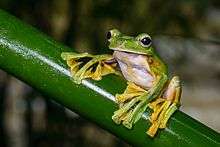Wallace's flying frog
Wallace's flying frog or the Abah River flying frog (Rhacophorus nigropalmatus) is a moss frog found at least from the Malay Peninsula into western Indonesia, and is present in Borneo and Sumatra. It is named for the biologist, Alfred R. Wallace, who collected the first specimen to be formally identified.
| Wallace's flying frog | |
|---|---|
 | |
| Scientific classification | |
| Kingdom: | Animalia |
| Phylum: | Chordata |
| Class: | Amphibia |
| Order: | Anura |
| Family: | Rhacophoridae |
| Genus: | Rhacophorus |
| Species: | R. nigropalmatus |
| Binomial name | |
| Rhacophorus nigropalmatus Boulenger, 1895 | |
R. dennysii, R. maximus and Polypedates feae were once contained within Wallace's flying frog as subspecies. Similar frogs also occur in Laos, Vietnam, Malaysia, Thailand and southern China; these may be R. nigropalmatus or an undescribed, closely related species.[1]
Description[2]
This frog is quite photogenic, due to its large size, brilliant colors, and interesting behavior.[3] With a body length of 80–100 mm (males are smaller than females), it is one of the largest species of Rhacophorus. Its eardrums are large, as well as its eyes, which feature horizontal pupils. Its limbs are very long, and its fingers and toes are webbed right to the tips. Together with a fringe of skin stretching between the limbs, this flying frog can parachute to the forest floor from high in the trees where it is normally found.
Its back is bright shiny green and the underside is white to pale yellow. The upper sides of the inside toes, as well as the outer parts of the toe and finger webbing, are brilliant yellow. The base of the webs and one flank spot per side are jet black. Overall, this frog looks much like the green flying frog (R. reinwardtii) and R. kio, which even if full grown do not reach the size of Wallace's flying frog, though, and have more orange web fringes.
They live almost exclusively in the trees, descending only to mate and lay eggs, and leaps and "flies" from tree to tree or to bushes. When threatened or in search of prey, they will leap from a branch and splay their four webbed feet. The membranes between their toes and loose skin flaps on their sides catch the air as they fall, helping them to glide, sometimes 50 feet (15 meters) or more, to a neighboring tree branch or even all the way to the ground. They also have oversized toe pads to help them land softly and stick to tree trunks. They survive mainly on insects, but have been known to consume toads and small birds.[4] The species is known to fall prey to tree climbing snakes.[5]
See also


Footnotes
- van Dijk, P.P.; Iskandar, D.; Inger, R. (2004). "Rhacophorus nigropalmatus". IUCN Red List of Threatened Species. 2004: e.T59008A11866922. Retrieved 3 June 2020.
- Tunstall (2003), Bordoloi et al. (2007)
- Sukumaran (2005)
- http://animals.nationalgeographic.com/animals/amphibians/wallaces-flying-frog/
- http://www.ecologyasia.com/verts/amphibians/wallace%27s_flying_frog.htm
References
| Wikispecies has information related to Rhacophorus nigropalmatus |
| Wikimedia Commons has media related to Rhacophorus nigropalmatus. |
- Bordoloi, Sabitry; Bortamuli, Tutul; Ohler, Annemarie (2007). "Systematics of the genus Rhacophorus (Amphibia, Anura): identity of red-webbed forms and description of a new species from Assam" (PDF). Zootaxa (1653): 1–20.CS1 maint: multiple names: authors list (link)
- Sukumaran, Jeet (2005). "Encounter with Wallace's Flying Frog, The Frog of the Monsoons".
- Tunstall, Tate, ed. (2003). "Rhacophorus nigropalmatus, Wallace's Flying Frog". AmphibiaWeb. Retrieved 22 June 2007.
